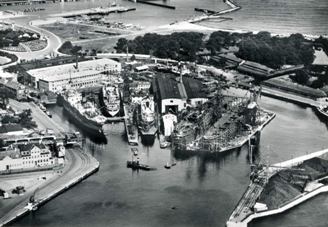The story of Elsinore begins in the late 1100s
In the 11th century at the natural crossing point between Zealand and Skåne (Sweden). Helsingør is mentioned several times in the 12th century, where the city probably already got the status of a city of purchase. The town, however, had a small hinterland, which consisted mostly of forest, but due to its location, the city became rapidly important. For the shipping traffic through the Sound.
The Great Herring Adventure
The great herring adventure took place in the 12th and 1300s along the entire Øresund coast. Here, up to 20,000 people gather in the fishing villages around the Sound - a real whirl of fishermen, merchants, full seamen, smugglers, gels, spies, gypsies and explorers. It is known from records that a ship sailing from Rostock in 1267 with a course against Skanør had 40 hooks on board. It is estimated that the herring catches in good years throughout the Øresund area could reach 200-300,000 barrels. The herring created a large and extensive market because of the provisions of the Catholic Church, which made all Wednesdays and Fridays, as well as the 40 days between permanent names and Easter for meatless days, and therefore was also a decisive factor for the Danish economy in the Middle Ages. With the precious salt from the great salt thirst at Lüneburg it became possible to preserve the herring, lowered them into barrels, so that they could stay under long transport to places throughout Europe. The story tells - if it is true to be untrue - that this wealth of 'silver' stood so close that you could cross the strait between Helsingør and Helsingborg and catch the herrings with their bare fists. Herring can be caught in Danish waters throughout the year. However, the fat harvested herring, caught from late July to the beginning of November, is considered the most tasty and the one best suited for smoking, salting and marinating. Spring and Summer, which are skinny and therefore become faster, are best suited for roasting.
 |
| Erik af Pommern King of Denmark 1426 |
Helsingør in the Middle Ages
King Erik of Pomerania introduced in the 1420s the Øresund customs (Sound customs) and demanded a tax on all ships passing through Øresund. At the same time he began the construction of the Ørekrog or Krogen castle in order to put power behind the new customs collection. King Erik of Pomerania also gave extensive privileges in 1426 and developed the city to an important church center with several monasteries.
 |
| Frederik the 2. King of Denmark |
The town of Elsinore 1536-1850
In the 16th century Frederik revolved the 2nd medieval castle 'Krogen' and instead built Kronborg Slot. Elsinore gained several benefits and benefited from the lively trade of the unscheduled ships on the nest waiting to pay duty. Customs and soldiers created a special life in Elsinore. The 15th and 16th centuries were a good time for Elsinore, though the city was repeatedly affected by serious epidemics that were brought in by the many ships. In the latter half of the 17th century the Customs Bridge was expanded, and a new highway improved the connection to Copenhagen. In 1824 the harbor was taken over by the state, which modernized the port facility, so that the big ships could add.
At the beginning of the 18th century, the annual income from the Sound customs tax at that time about 2.8 million. Rd. and Helsingør was at that time one of the most important cities in northern Europe.
Industrialization and Urban Growth
With the abolition of the Øresund Customs in 1857, the city lost huge revenues. The business life associated with clearance operations did not disappear, however, as the cancellation of the Øresund Customs(Sound Customs), meant more ships through the Sound.
Some of them sailed to Helsingør to buy supplies, while at the same time maintaining the status of ordering port for the Baltic countries. But back it went for the city and the population still stagnant. In return, Helsingør enjoyed the steamship to Skåne (Sweden) from the late 18th century. In 1892 the railway opened to Copenhagen and the increasing tourist flow from the capital.
The most important industry was now the yard, or Helsingør's Iron Ship and Machine Building, which was built in 1881. The shipyard employed about 700 to 800 workers around the turn of the century, which meant that it again began to go forward. For Elsinore.
 |
| Elsinore Shipyard 1939 |
Industry City 1900-1970
Especially the yard and the important location meant that in the early 1900s it was again. Helsingør began to grow rapidly. From the 1930s onwards, the population increased from about 18,000 to about 42,000 in 1970. At the same time as population growth, Helsingør's area was tripled from 1930 to 1970. Elsinore became attractive as a holiday town and many holiday homes were built in the area. Around 1960 the yard was still by far the most important company in the city and had about 2,700 employees. About ten tenths in Elsinore worked at the yard at that time.
After Industry 1970 to Today
The city's development has been highly influenced by the yard, as evidenced by the business distribution. The newbuilding department of the shipyard closed in 1983. This is also seen by the population, which peaked in the mid 1970s and then went back in the 1980s. Now Helsingør is more of a commuter suburb of the Capital Region.
Read more about Sund-customs and Helsingør's amazing history
Also read about the Oeresund Customs accounts